NCERT Solutions for Exercise 9.2 Class 9 Maths Chapter 9 - Areas Of Parallelograms And Triangles
NCERT Solutions for Class 9 Maths chapter 9 exercise 9.2 has six questions based on the notion of a parallelogram with the same base and parallels. The questions consist of proving the area of two figures equal, finding any side, etc. NCERT book Exercise 9.2 Class 9 Maths has various standard questions that help to have in-depth knowledge of the topic. NCERT syllabus Class 9 Maths chapter 9 exercise 9.2. also has one problem-based question that gives a practical understanding of the topic,
This Story also Contains
- Areas Of Parallelograms And Triangles Class 9 Chapter 9 Exercise: 9.2
- More About NCERT Solutions for Class 9 Maths Exercise 9.2
- Benefits of NCERT Solutions for Class 9 Maths Exercise 9.2
- NCERT Solutions of Class 10 Subject Wise
- Subject Wise NCERT Exemplar Solutions
NCERT solutions for Class 9 Maths exercise 9.2 focuses on the parallelograms on the same base, and between the same parallels, its solution gives a new perspective to solve the questions. The solution of this exercise provides the students with confidence in this topic.
A parallelogram is a figure in which two opposite sides are parallel to each other whose diagonals are not equal. In Class 9 Maths chapter 9 the following exercises are also present.
- Areas Of Parallelograms And Triangles Exercise 9.1
- Areas Of Parallelograms And Triangles Exercise 9.3
- Areas Of Parallelograms And Triangles Exercise 9.4
Areas Of Parallelograms And Triangles Class 9 Chapter 9 Exercise: 9.2
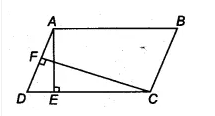
![]() Answer:
Answer:
We have,
AE $\perp$ DC and CF $\perp$ AD
AB = 16 cm, AE = 8 cm and CF = 10 cm
Since ABCD is a parallelogram,
therefore, AB = DC = 16 cm
We know that, area of parallelogram (ABCD) = base . height
= CD $\times$ AE = (16 $\times$ 8 ) $cm^2$
SInce, CF $\perp$ AD
therefore area of parallelogram = AD $\times$ CF = 128 $cm^2$
= AD = 128/10
= AD = 12.8 cm
Thus the required length of AD is 12.8 cm.
Q2 If E, F, G and H are respectively the mid-points of the sides of a parallelogram ABCD, show that
$\small ar(EFGH)=\frac{1}{2}ar(ABCD)$
Answer:
Join GE and HE,
Since F, F, G, H are the mid-points of the parallelogram ABCD. Therefore, GE || BC ||AD and HF || DC || AB.
It is known that if a triangle and the parallelogram are on the same base and between the same parallel lines. then the area of the triangle is equal to the half of the area of the parallelogram. 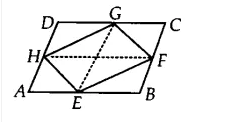
![]()
Now, $\Delta$ EFG and ||gm BEGC are on the same base and between the same parallels EG and BC.
Therefore, ar ( $\Delta$ EFG) = $1/2$ ar (||gm BEGC)...............(i)
Similarly, ar ( $\Delta$ EHG) = 1/2 . ar(||gm AEGD)..................(ii)
By adding eq (i) and eq (ii), we get
ar ( $\Delta$ EFG) + ar ( $\Delta$ EHG) = 1/2 (ar (||gm BEGC) + ar(||gm AEGD))
ar (EFGH) = 1/2 ar(ABCD)
Hence proved
Answer:
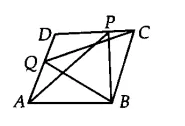
![]()
We have,
ABCD is a parallelogram, therefore AB || CD and BC || AD.
Now, $\Delta$ APB and ||gm ABCD are on the same base AB and between two parallels AB and DC.
Therefore, ar ( $\Delta$ APB) = 1/2 . ar(||gm ABCD)...........(i)
Also, $\Delta$ BQC and ||gm ABCD are on the same base BC and between two parallels BC and AD.
Therefore, ar( $\Delta$ BQC) = 1/2 . ar(||gmABCD)...........(ii)
From eq(i) and eq (ii), we get,
ar ( $\Delta$ APB) = ar( $\Delta$ BQC)
Hence proved.
[ Hint : Through P, draw a line parallel to AB.]
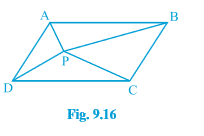 Answer:
Answer:
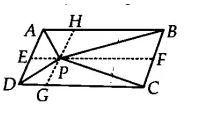
![]()
We have a ||gm ABCD and AB || CD, AD || BC. Through P, draw a line parallel to AB
Now, $\Delta$ APB and ||gm ABEFare on the same base AB and between the same parallels EF and AB.
Therefore, ar ( $\Delta$ APB) = 1/2 . ar(ABEF)...............(i)
Similarly, ar ( $\Delta$ PCD ) = 1/2 . ar (EFDC) ..............(ii)
Now, by adding both equations, we get
$\small ar(APB)+ar(PCD) = \frac{1}{2}ar(ABCD)$
Hence proved.
Q4 (ii) In Fig. $\small 9.16$ , P is a point in the interior of a parallelogram ABCD. Show that
$\small ar(APD)+ar(PBC)=ar(APB)+ar(PCD)$
[ Hint: Through P, draw a line parallel to AB.]
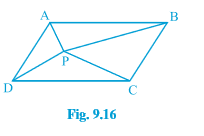
Answer:
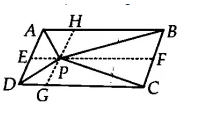
![]()
We have a ||gm ABCD and AB || CD, AD || BC. Through P, draw a line parallel to AB
Now, $\Delta$ APD and ||gm ADGHare on the same base AD and between the same parallels GH and AD.
Therefore, ar ( $\Delta$ APD) = 1/2 . ar(||gm ADGH).............(i)
Similarily, ar ( $\Delta$ PBC) = 1/2 . ar(||gm BCGH)............(ii)
By adding the equation i and eq (ii), we get
$\small ar(APD)+ar(PBC)=ar(APB)+ar(PCD)$
Hence proved.
Q5 In Fig. 9.17, PQRS and ABRS are parallelograms and X is any point on side BR. Show that
(i) $\small ar(PQRS)=ar(ABRS)$
(ii) $\small ar(AXS)=\frac{1}{2}ar(PQRS)$
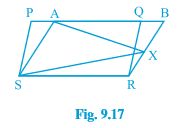 Answer:
Answer:
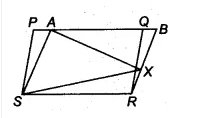
![]()
(i) Parallelogram PQRS and ABRS are on the same base RS and between the same parallels RS and PB.
Therefore, $\small ar(PQRS)=ar(ABRS)$ ............(i)
Hence proved
(ii) $\Delta$ AXS and ||gm ABRS are on the same base AS and between same parallels AS and RB.
Therefore, ar ( $\Delta$ AXS) = 1/2 . ar(||gm ABRS)............(ii)
Now, from equation (i) and equation (ii), we get
$\small ar(AXS)=\frac{1}{2}ar(PQRS)$
Hence proved.
Answer:
We have a field in the form of parallelogram PQRS and a point A is on the side RS. Join AP and AQ. The field is divided into three parts i.e, $\Delta$ APS, $\Delta$ QAR and $\Delta$ PAQ. 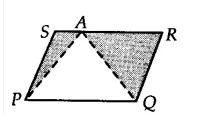
![]()
Since $\Delta$ APQ and parallelogram, PQRS is on the same base PQ and between same parallels RS and PQ.
Therefore, $ar(\Delta APQ) = \frac{1}{2}ar(PQRS)$ ............(i)
We can write above equation as,
ar (||gm PQRS) - [ar ( $\Delta$ APS) + ar( $\Delta$ QAR)] = 1/2 .ar(PQRS)
$\Rightarrow ar(\Delta APS)+ar(\Delta QAR) = \frac{1}{2}ar(PQRS)$
from equation (i),
$\Rightarrow ar(\Delta APS)+ar(\Delta QAR) =ar(\Delta APQ)$
Hence, she can sow wheat in $\Delta$ APQ and pulses in [ $\Delta$ APS + $\Delta$ QAR] or wheat in [ $\Delta$ APS + $\Delta$ QAR] and pulses in $\Delta$ APQ.
More About NCERT Solutions for Class 9 Maths Exercise 9.2
Class 9 Maths chapter 9 exercise 9.2 is about the parallelogram in the same base and same parallels. It has six questions, among which one question is application-based, all in all, the exercise is packed with standard questions aiming to give students in-depth knowledge. Exercise 9.2 Class 9 Maths -Parallelogram is a geometric figure in which the opposite sides are parallel; using this very concept, the questions on this exercise could be tackled efficiently. The NCERT solutions for Class 9 Maths exercise 9.2 mainly focuses on the various properties exhibited by the parallelogram. Exercise 9.2 Class 9 Maths primary focus is to enlighten and give good practice to the topic; that is why it has a nice set of standard questions.
Also Read| Areas Of Parallelograms And Triangles Class 9 Notes
Benefits of NCERT Solutions for Class 9 Maths Exercise 9.2
• The NCERT solutions for Class 9 Maths exercise 9.2 assists students in solving and revising all of the problems in this exercise.
• If you go over the NCERT solutions for Class 9 Mathematics chapter 9 exercise 9.2, you will be able to gain more marks, and if you practice it completely, it will help you score well in maths in examinations.
• Parallelograms on the same base and between the same parallels are the basis of exercise 9.2 Class 9 Maths.
Also, See
NCERT Solutions of Class 10 Subject Wise
Subject Wise NCERT Exemplar Solutions
Popular Questions
Courses After 12th
Applications for Admissions are open.
As per latest syllabus. Physics formulas, equations, & laws of class 11 & 12th chapters
JEE Main Important Chemistry formulas
Get nowAs per latest syllabus. Chemistry formulas, equations, & laws of class 11 & 12th chapters
JEE Main high scoring chapters and topics
Get nowAs per latest 2024 syllabus. Study 40% syllabus and score upto 100% marks in JEE
JEE Main Important Mathematics Formulas
Get nowAs per latest syllabus. Maths formulas, equations, & theorems of class 11 & 12th chapters
